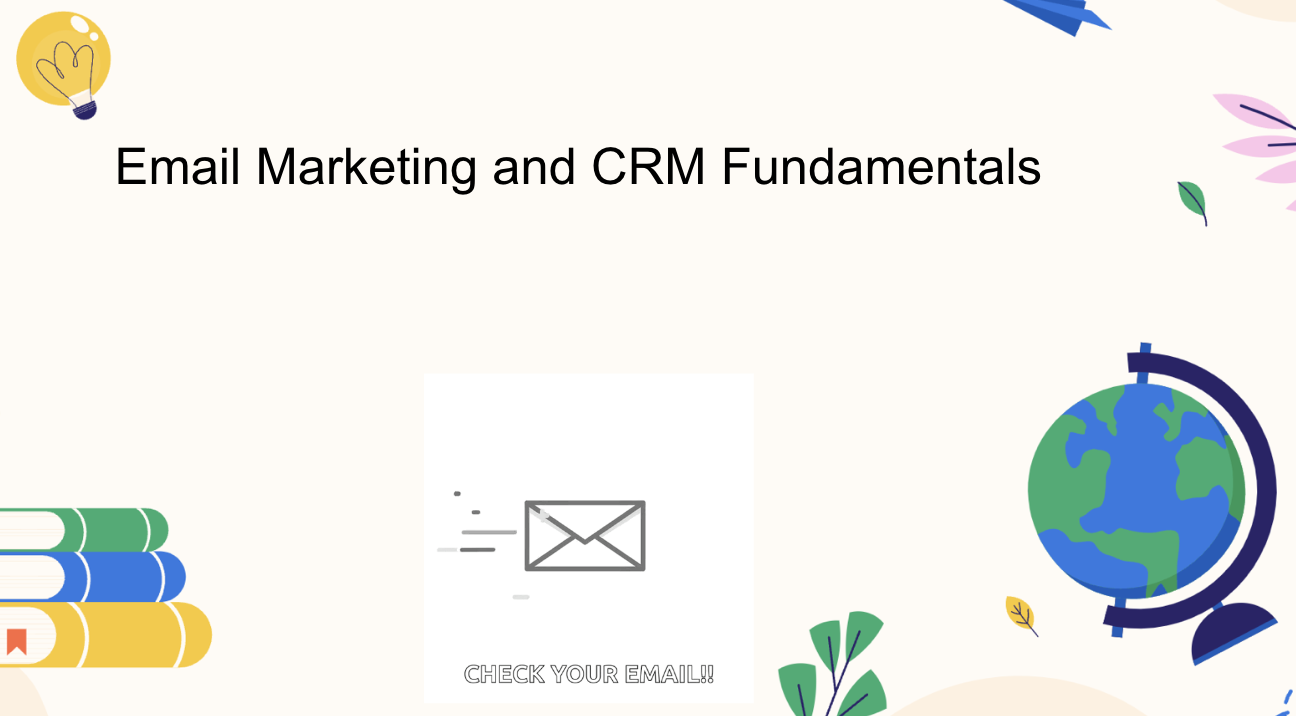Digital Marketing Course: Email Marketing and CRM Fundamentals.
Definition and Importance
- Email marketing and CRM (Customer Relationship Management) are crucial components of digital marketing strategy.
- Email marketing involves sending targeted emails to a specific audience to generate engagement, leads, and sales and build customer relationships.
- A CRM system manages and analyses customer interactions and data to improve long-term relationships.
Subject Lines
One key aspect of email marketing is getting your contacts to open your email and react to the content.
This is where the importance of subject lines plays a vital role.
- Headline Analyser by Aminstitute.com helps you create a compelling subject line.
- Writing a great email means nothing if no one opens it!
- Add personalisation @FirstName
- Avoid traps and clickbait titles!!!!!!! (excessive punctuation is a way to get into trouble).
Homework Task:
Can you write a subject line that will keep you out of the bin?
Use a Headline Analyser tool to help craft the perfect text, like the one from Aminstitute.com.
Remember to revise the latest updates on Key Digital Marketing Terms and Abbreviations.
Key Components
- – Customer Journey Mapping: Understanding the customer lifecycle from initial awareness to post-purchase.
- – Database Management: Ensuring data accuracy, segmentation, and growth
- – Email Campaign Creation: Designing engaging campaigns for different customer segments
- – A/B Testing: Experimenting with email elements to optimise performance
- Performance Analysis: Tracking and analysing campaign metrics
- –CRM Strategy Development: Building and implementing strategies to foster strong customer relationships
- – Data Analysis: Leveraging customer data for targeted marketing campaigns
- – Automation: Implementing automated email sequences and workflows.
Email Campaign Creation
- Design engaging campaigns for different segments.
- It’s important to tailor content for audience engagement: New client or returning guest? Use different tones and content!
- Use tools and platforms for campaign creation. Know your Brand to maintain style and message.
- First, objectives. Use Forms, QR codes, landing pages, and database segmentation to maintain healthy list management.
Email Authentication Protocols
Overview of DKIM, DMARC, and SPF.
- These three protocols form a robust email authentication system that helps prevent phishing, spoofing, and other email-based attacks.
- By implementing these protocols, organisations can significantly improve their email security and ensure their legitimate emails are more likely to reach recipients’ inboxes.
SPF is an email authentication method that specifies which mail servers are authorised to send email on behalf of a domain. It helps prevent email spoofing and reduces the risk of spam and phishing attacks.
- In other words:
- SPF is like a guest list for a party. Imagine your domain is hosting an email party, and SPF is the bouncer checking IDs at the door. It’s a list of authorised servers (party guests) that can send emails on your domain’s behalf. When an email arrives, the receiving server checks this list to ensure the sender is on it.
- Key points:
- • It verifies that the email comes from an authorised server
- • It helps prevent email spoofing
- • It’s published in the DNS (Domain Name System) record
DKIM is an email authentication standard that uses cryptographic signatures to verify the integrity of an email from the sender to the recipient. The receiving server can confirm that the claimed domain sent the email and wasn’t altered during transit.
In other words:
- DKIM is like a wax seal on a letter. In the old days, important letters were sealed with wax and a unique stamp to prove they weren’t tampered with during transit. DKIM does the same thing for emails by adding a digital signature.
- Key points:
- • It adds a cryptographic signature to the email
- • It verifies the email’s integrity and authenticity
- • It helps prevent email tampering
DMARC is an email authentication, policy, and reporting protocol that builds on SPF and DKIM. It links the author’s domain name, published policies for handling authentication failures and reporting from receivers to senders. DMARC helps improve and monitor the protection of the domain from fraudulent email.
In other words:
- DMARC is like a set of instructions for the mail room. It tells receiving servers what to do
if an email fails the SPF or DKIM checks. It’s also like a security guard reporting any suspicious activity to you.
- Key points:
- • It provides a policy for handling emails that fail authentication and can instruct servers to deliver, quarantine, or reject suspicious emails
- • It offers reporting capabilities to help monitor email authentication
How SPF, DKIM, and DMARC Work Together
Think of them like a letter delivery system:
- SPF checks if the mailman is from an authorised post office (Is the sender allowed to do so?).
- DKIM is like verifying the wax seal on the envelope hasn’t been broken (Has the message been tampered with?).
- DMARC is like instructions for the recipient on what to do if the mailman isn’t recognised or the seal is broken (What should we do with suspicious mail?).
- These three protocols form a robust email authentication system that helps prevent phishing, spoofing, and other email-based attacks.
- Implementing these protocols can significantly improve email security and ensure that legitimate emails are more likely to reach recipients’ inboxes.
(Yet more reasons to have a dedicated domain and not use personal email for work.)




